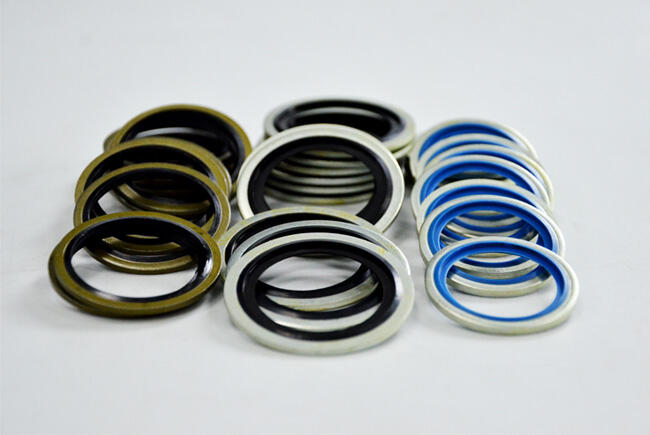Bonded seal combine a metal frame with rubber to provide stable end-face seals in bolts, threaded joints, and pipe fittings. They are particularly suitable for mechanical engineering, hydraulic and pneumatic systems, and oil and gas applications. They are simple to assemble, seal with a single tightening action, and require relatively low mating surface finishes. They quickly establish a reliable seal in confined spaces, minimizing downtime and repairs.
Structure and Materials: Small Structure, Big Dimensions
· Composed of two parts: a metal outer ring (commonly carbon steel or stainless steel) and an elastomeric sealing lip (commonly NBR) inner ring. The rubber vulcanizes securely to the metal under heat and pressure, preventing displacement and extrusion.
· Self-centering and Non-self-centering: Some models feature a guide flange on the inner diameter for automatic centering during assembly, known as "self-centering bonded seal." Non-self-centering versions are also available to accommodate more flexible assembly spaces and non-standard configurations.
Material Options:
· Metal Rings: Carbon steel, zinc-plated/phosphated, 304/316 stainless steel; special alloys can be customized upon request.
· Elastomers: NBR (oil-resistant, general purpose), FKM (high-temperature, chemical-resistant).
· Surface Treatments: Galvanizing, Dacromet, phosphating, nickel plating, etc., to enhance corrosion resistance and smooth assembly.
Pressure, Temperature, and Sealing Mechanism
· Sealing Mechanism: Tightening force creates a controlled compression of the rubber lip between the two sealing surfaces. The metal ring restricts lateral flow of the rubber and provides anti-burst support, making it more resistant to high pressures and extrusion than simple rubber gaskets.
· Pressure Rating: The standard design is generally suitable for medium- and high-pressure static sealing, with common hydraulic connections reaching static pressures of up to tens of MPa. Reinforced or thick-walled metal ring designs can further enhance pressure resistance. The actual upper limit depends on the size, material, and surface finish and should be verified based on the operating conditions.
· Temperature range (typical values, subject to formulation): NBR approximately -40 to 125°C; FKM approximately -20 to 250°C. The closer the temperature reaches the upper limit, the more attention should be paid to long-term compression set and media compatibility.
· Compared to O-rings: bonded seal feature built-in metal stoppers and rubber retaining features, are less dependent on groove machining and seal cavity geometry, and offer greater assembly tolerance. They are suitable for end-face sealing applications such as bolt heads, threaded ends, and plugs.

Applicable Applications and Industries
· Typical Connections: Bolt/stud end-face sealing, shoulder seals for BSP, NPT, Metric, and SAE threaded joints, flange auxiliary sealing, plugs, and sensor mounting locations.
· Critical Operating Conditions: High-pressure sealing, thermal cycling, contact between oil and chemical media, and assembly points subject to vibration and micro-displacement.
Industries and Equipment (Highly Compatible with bonded seal):
· Pumps, motors, transmissions, engines, and lubrication systems
· Hydraulic and pneumatic systems, construction machinery, and agricultural machinery
· Oil and gas extraction and transportation, chemical and metallurgical equipment, and the energy sector (including wind turbine nacelles and hydraulic yaw/pitch systems)
· Water treatment equipment, marine/offshore connections, and hydraulic modules for heavy-duty truck and automotive chassis
Hydraulic actuators in industrial machinery, robotic arms, and some industrial robots commonly require threaded/bolted connections and high-pressure seals. bonded seals offer a "tighten and seal" approach that improves assembly efficiency and seal life.
NQKSF Brand and Service: Attention to Sealing Details
NQKSF has been deeply involved in the oil seal and O-ring industry for over 30 years, strictly adhering to ISO 9001 and TS16949 standards and developing integrated R&D, manufacturing, and quality control capabilities.
Service Capabilities:
· Standard parts in stock for immediate delivery: Covering tens of thousands of specifications for O-rings, oil seals, and more, with ample inventory to accommodate emergency shutdowns and spare parts replenishment.
· Customized, full-service service: From material selection, structural optimization, coating and custom dimensions, to sample testing, we tailor the solution to your application.
· Technical Empowerment: Leveraging over 30 years of industry experience, we optimize seal stack designs for hydraulic/pneumatic systems, helping reduce maintenance costs and improve reliability.
Company Highlights:
· Physically-built intelligent manufacturing plant; a brand deeply embedded in the sealing industry
· Wide range of models and abundant inventory
· Sold to over 80 countries worldwide
· Partnering with globally renowned brands
· Provincial Technology Innovation Center, Specialized and New Enterprise, High-tech Enterprise
· Leader in Featured Industrial Clusters
Key Points for Selection and Installation
· Material Selection: Prioritize matching the elastomer to the medium and temperature, followed by the corrosion resistance and strength of the metal ring. For long-term exposure to marine environments, stainless steel is preferred.
· Dimensions: Select inner and outer diameters that match the bolt/thread shoulder. The self-centering structure improves assembly efficiency and concentricity.
· Surface and Pre-Tightening: The sealing surface should be flat, with a roughness no greater than Ra 1.6 μm. Apply torque according to the bolt grade and lubrication conditions to avoid overloading and squeezing the rubber.
· Reusability: This is a consumable item requiring "visual inspection." If scratches, dents, or aging occur, it should be replaced.
· Pressure Testing and Maintenance: During initial assembly, it is recommended to increase the pressure in stages and recheck for leaks. Retightening after thermal cycling can improve long-term stability.
The bonded seal series solves the age-old problem of "how to seal high-pressure end faces" with a simple yet ingenious structure. It reduces machining and assembly complexity while providing reliable sealing redundancy during equipment upgrades and maintenance cycles. If you're looking for a reliable solution for high-pressure threaded or bolted connections, consider combining a bonded seal as a priority. If you require non-standard dimensions or specialized media, contacting NQKSF is engineering team will help you find the right solution faster.
 Hot News
Hot News